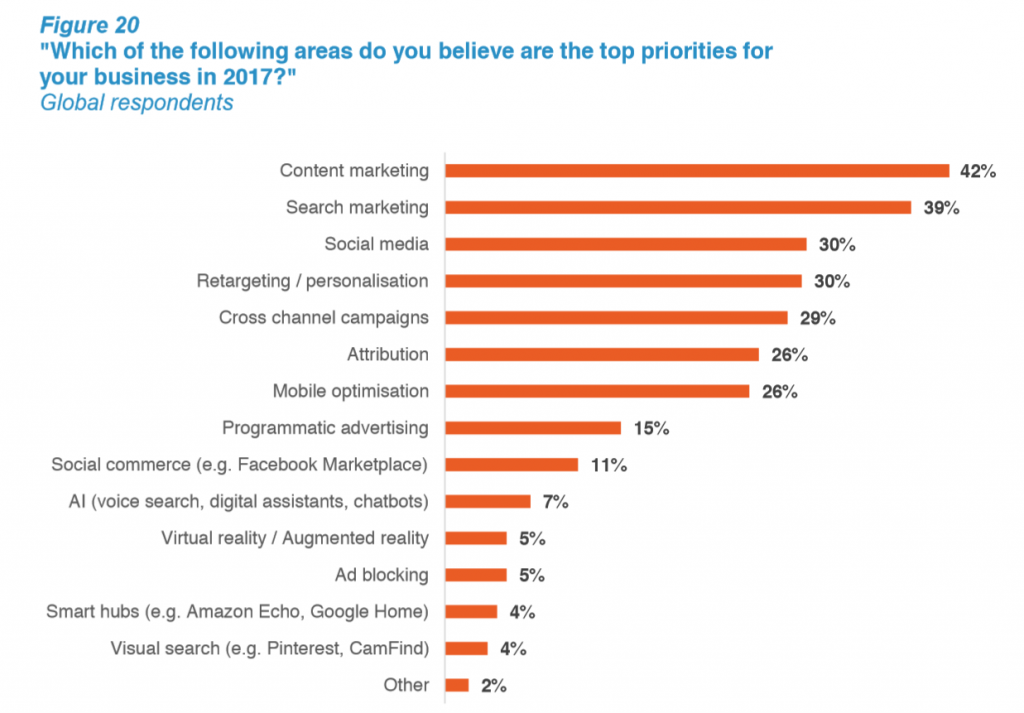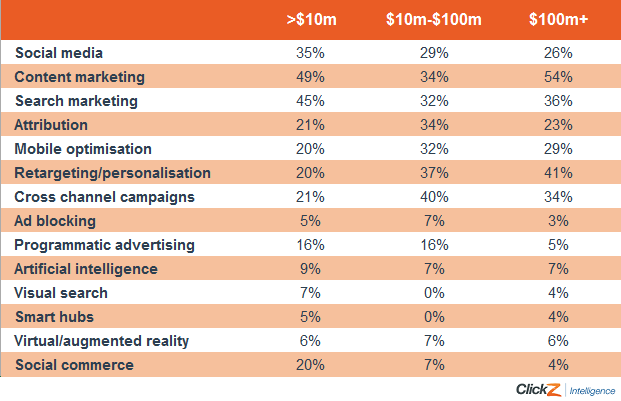We can’t believe how quickly 2017 is racing by! Easter has already come and gone and the summer Bank Holiday season is about to hit. Our personal New Year resolutions for 2017 are probably ancient history by now but what about our business goals and visions for this year?
Earlier this year more than 500 advertisers around the world gave us their secrets about ad spend, and top business priorities for 2017. The resulting report – The State of Digital Advertising 2017 – made interesting reading.
A summary of results is shown in the chart below:

Top of the list by some considerable margin are content marketing and search marketing, showing that the fundamentals of marketing are as important as they ever were.
The report also indicates which of the newer technologies are attracting the most interest from advertisers, which is interesting in terms of the potential future direction of digital multichannel marketing.
Social commerce
This is the highest new area of interest, with11% of advertisers saying that they plan to prioritise it during 2017. Social commerce is a new concept combining elements of social networking and ecommerce.
For example, when a brand leverages a social platform to sell their products and services directly without the consumer having to be redirected away from the social platform to a separate landing page; they can buy the desired products without leaving the social platform.
Buy buttons and shopping features can be added to Twitter, Instagram, Facebook and other social platforms to enable the direct purchase of products and services. The combination of social networking and ecommerce can also facilitate the sharing of product details and opinions during the purchase process.

Artificial intelligence
7% of advertisers plan to prioritise artificial intelligence, either by the use of chatbots, digital assistants or voice search – an increasingly important trend in the search marketing industry.

AI tools can also be used to collect the data that customers are willingly inputting through these mechanisms. As this data is used to supplement customer profiles, this will in turn facilitate a more thorough and complete picture of ideal target audience.
Virtual reality
More adventurous businesses are experimenting with using virtual reality – fully immersive computer simulated environments that give the user the feeling of actually being in that environment – to enhance the user’s advertising experience.
The purpose may be sheer entertainment, emotional connection or to share a message – but ,used effectively, virtual reality can make a huge difference to consumer connection with the brand.
Smart hubs
Smart home hubs – such as Amazon Echo or Google Home – can be used for marketing purposes. These voice-activated home speaker systems include personal voice assistants via which users can ask the device questions and get information.

An ideal new marketing opportunity if a brand is willing to work with the types of skills available on these devices.
Visual search
Our recent blog Pin Your Hopes on This examined the way that Pinterest is now developing its own ad offering. It is in discussions with other platforms to further expand its presence in search.
Around 150 million users visit Pinterest monthly and its global head of partnerships Jon Kaplan (formerly of Google) claims that its number of users in the U.S. is now the same size as Twitter, if not larger. There are also an estimated 300 million active Snapchat users and Snapchat is poised for explosive growth this year with its ad revenue anticipated to grow by 157.8%.

Interestingly, when the above priorities are broken down by business size it is apparent that smaller businesses – defined by the survey as those with an annual revenue of less than $10 million – are more willing to take a gamble on new technology.
Examining the five areas we looked at above in the table below, all but virtual reality have higher spend in small businesses (and even virtual reality spend is only slightly exceeded by medium-sized businesses).
In particular social commerce spend in small businesses is almost triple that of medium businesses and five times that of large businesses.

At this stage it is unclear as to whether small businesses are simply more willing in general to take risks on new technologies – in the hope that this will pay dividends in the long run – than larger businesses, who have more money to invest and therefore potentially more to lose.
….Or it could be that small businesses are in the process of focussing their efforts on a specific niche.
Either way, it will be interesting to monitor the use of these new technologies in multichannel marketing throughout the rest of 2017, and how the answers to any similar survey in early 2018 compared to those examined above.

